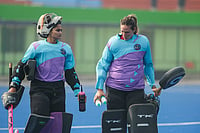Three women from our sacred literature have always stood out: the beautiful pativrata Sita; the fiery, vengeful Draupadi, who engendered a catastrophic 18-day war between brothers; and Radha, the beautiful and equal partner of Krishna who remained the ‘other’ woman. As a woman growing up in metropolitan India, having the luxury of going to one of the finest public schools in Lutyens’ Delhi—the Convent of Jesus and Mary, and enjoying the privilege of the inner circles of the rich and famous, backed by the intellectual rigour of the ‘kathasaritasagar’ of Indian culture, I am today questioning the stereotypical sketches of these three icons of Indian womanhood.
I am surprised at the growing marginalisation of the consorts of male gods in our sacred literature, and the growth of strident, patriarchal tropes of Ram. Earlier, Jai Siya Ram was the common greeting. Now it is Jai Sri Ram. But where is Radhey Radhey? Why is Sita relegated to anonymity and Draupadi being removed from the syllabi of University of Delhi? This set me thinking about how I view these three icons of feminine power from our sacred literature.
For most Indian women, Sita, Draupadi and Radha, have been part of their collective consciousness. While recalling the three women, I realised that Sita and Radha are popular names given to women, but I have not come across a woman called Draupadi. This set me thinking. Then, during the first month of the nationwide Covid-19 lockdown last year, the three women re-entered my creative imagination. Doordarshan had started a rerun of the serialised epics, Ramayana and Mahabharata.
Once I started watching them, I was completely hooked. The serials were extremely well-researched and spoke a popular language culled mainly from regional and vernacular resources. This became a point of inclusion and representation of both Sita and Draupadi. My third muse—Radha, the older woman who knew her mind—was clear about her ‘self’. And her extra-marital relationship could be accepted even by the most rigid of patriarchs because it was being seen through the lens of Bhakti.
In the Ramayana, where the majority of characters are noble with lofty ideals, Sita was the selfless wife who left the comforts of the palace for the sake of her husband, and not only gave up her security and rights as a wife, but also those of her unborn children. She had to go through not just one but two trials of fire to prove her fidelity and devotion to her husband Ram, the king of Ayodhya. On the whim of an accusation levelled on her by an unlettered washerman, who wanted to assert his patriarchal supremacy over his own wife, Sita was pressured into leaving the palace in the middle of the night.
Through the many centuries since the Ramayan was written, recited in almost all homes and annually enacted in villages of north India, days before the celebration of the festival Dussehra—Sita is painted as this long-suffering wife and committed mother who sacrifices all just so that her husband Ram could be hailed as the most righteous king of all. I would, as a woman living in the age of #metoo, like to have more re-telling of Sita’s story.
In this regard, the recovery of the text Rewriting the Ramayana: Chandrabati and Molla by author and academic Nabaneeta Dev Sen is a welcome entry into the understanding and reinterpretation of Sita’s character. Another very potent, contemporary critique of Sita is in the novel The Forest of Enchantments by Chitra Banerjee Divakaruni. Banerjee’s Sita is a livewire with strong feelings for her love, Ram. The Malayali poet Kamala Das started writing autobiographical verses about physical intimacy and sexuality in her personal voice. Scholar Ramakant Raut in Orissa asked a relevant question, “Why shouldn’t there be a Sitayana too, instead of only the Ramayana?”

[from left] Draupadi, Radha, Sita (fiction), Bama, Sukirtharani, Mahasweta Devi (truth)
It is important for Indians, particularly the younger generations who are far more curious and inquisitive, to access non-patriarchal and non-hierarchical interpretations of Sita. How is it that Sita, who carves her own path, goes on a solitary journey and finally rejects Ram’s hesitant acceptance of her as a woman? Sita’s final triumph is when she refuses to take the second trial by fire, and instead merges into ‘prithvi’, the ground beneath her feet from which she was born.
Then there is the proud and beautiful Draupadi—the powerful woman who had to share her affections among five brothers, even though she had a soft corner for the man who had won her with his skill—Arjuna. She is a source of inspiration to millions of women across the world because of her ability to stick to her ground. She is the one who avenges her own humiliation in the court of Hastinapur by her own brother-in-law, the mighty Kaurava, Duryodhana.
Indian modernity has represented women through the lens of patriarchy, marginalising the scale, role and canvas of their voices. It is as recent as 1984 that the Centre for Women’s Development Studies (CWDS) was established at the University of Delhi, even though its mandate was women’s rights, not feminist studies. At least the directors and heads of departments were women. Thereafter, it was the 2001 census report on female infanticide that got educational institutions and policymakers to look into not just women’s rights, but also at ways to change the popular narrative around women.
It was then that cultural identity and sexuality of women came under focus and was included in this course, which further drove the identity politics of women. Feminism, and feminist readings of women’s voices started entering the stream of academic readings and disciplines. The Indira Gandhi National Open University (IGNOU), which was out of the purview of University of Delhi, seriously started viewing the importance of women’s empowerment through disciplines like literature, sociology, history and culture, and started offering a course on gender and women. Gender studies came into play, and with that, departments of gender studies began appearing in state universities across India. The focus on women’s rights started shifting, and began including women’s voices and re-readings of Indian mythology and literature.
Around 2006-2007, with the establishment of gender studies departments in many universities, post-colonial readings started questioning the colonial mindset. This was also the time when Article 377 of the Indian Constitution came under review. Same-sex love, trans-sexuality and gender- bending started entering the discourse. My own doctoral work, which was around Shiva’s leela murti, ie, ardhanarishvara, did not address these issues. It was after my postdoctoral stint at Goldsmiths University in London, in which I started looking at the image of ardhanarishvara not through the discipline of art history but through the prism of cultural studies, that a whole new world opened up for me.
I looked at the icon of ardhanarishvara as one of gender balance, having both aspects of male and female. While re-reading the texts, I found a whole world of inclusive discussion and debate, which, somewhere within the early wave of Indian modernism, had got swept under the carpet. The three waves of Western feminism completely marginalised the complex, nuanced thoughts around representation of women in our sacred literature.
Be it Sita, Draupadi or Radha, the different regions of India had their own interpretations. It’s time now for all of us to salvage vernacular literature and look at the modes of new knowledge. This has already started in India. With two anthologies of Sita and Radha, co-edited by Malashree Lal and Namita Gokhale, extensive writings on characters of the epic by young scholars like Parul Dasgupta, and popular interpretations of the epics on OTT platforms, inscribing new iconographies.
This is what I would celebrate. I think it is time to retrieve our vernacular knowledge, to tone down the strident strain of feminism and focus on the evolution of women’s voices, something I have already discussed. I am also welcoming the TV serials which are recreating the terrain of mythology for a fresh, insightful, coming-of-age of women’s voices. Production of new knowledge is what I would really like to be communicated, not just through English language, but also in regional tongues. It is time to celebrate our cultural diversity and rich tapestry of regionalism.
(Views expressed are personal)
Alka Pande, The writer is an academic and curator.


























